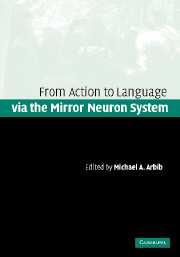Book contents
- Frontmatter
- Contents
- List of contributors
- Preface
- Part I Two perspectives
- Part II Brain, evolution, and comparative analysis
- 3 Cognition, imitation, and culture in the great apes
- 4 The signer as an embodied mirror neuron system: neural mechanisms underlying sign language and action
- 5 Neural homologies and the grounding of neurolinguistics
- Part III Dynamic systems in action and language
- Part IV From mirror system to syntax and Theory of Mind
- Part V Development of action and language
- Index
- References
4 - The signer as an embodied mirror neuron system: neural mechanisms underlying sign language and action
Published online by Cambridge University Press: 01 September 2009
- Frontmatter
- Contents
- List of contributors
- Preface
- Part I Two perspectives
- Part II Brain, evolution, and comparative analysis
- 3 Cognition, imitation, and culture in the great apes
- 4 The signer as an embodied mirror neuron system: neural mechanisms underlying sign language and action
- 5 Neural homologies and the grounding of neurolinguistics
- Part III Dynamic systems in action and language
- Part IV From mirror system to syntax and Theory of Mind
- Part V Development of action and language
- Index
- References
Summary
Introduction
“Mirror” neurons are found in area F5 of the monkey brain, and they fire both when a monkey grasps an object and when the monkey observes another individual grasping the object (e.g., Rizzolatti et al., 1996; see Arbib, Chapter 1, this volume, for further discussion). Mirror neurons have also been found in the rostral part of the monkey inferior parietal lobule (Gallese et al., 2002). Like mirror neurons, signers must associate the visually perceived manual actions of another signer with self-generated actions of the same form. Sign language comprehension and production requires a direct coupling between action observation and action execution. However, unlike mirror neurons for hand movements recorded in monkey, signing is not tied to object manipulation. Mirror neurons for grasping in monkey fire only when an object is present or understood to be present and do not fire when just the grasping movement is presented (Umiltà et al., 2001). Furthermore, unlike grasping and reaching movements, sign articulations are structured within a phonological system of contrasts. The hand configuration for a sign is determined by a phonological specification stored in the lexicon, not by the properties of an object to be grasped. These facts have interesting implications for the evolution of language and for the neural systems that underlie sign language and action.
The fact that sign language exhibits form-based patterning of meaningless elements (i.e., phonology) distinguishes signs from actions, even when the two appear quite similar on the surface; for example, the American Sign Language (ASL) sign TO-HAMMER resembles the act of hammering.
- Type
- Chapter
- Information
- Action to Language via the Mirror Neuron System , pp. 110 - 135Publisher: Cambridge University PressPrint publication year: 2006
References
- 3
- Cited by



